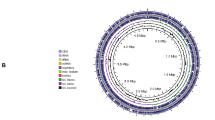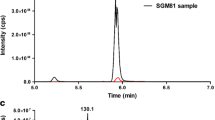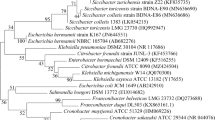Abstract
An endophytic beneficial bacterium was isolated and characterized from in vitro grown microshoots of Fraser’s Photinia (Photinia × fraseri Dress.) in our previous studies. This bacterium, which is nominated as PGB_invit and determined as a member of Pseudorhodoplanes sp., has ability to fix nitrogen and produce plant growth promoting regulators such as indole acetic acid and gibberellic acid. Due to its beneficial traits, this specific bacterium promotes in vitro proliferation of Fraser’s Photinia microshoots and enables microshoots to be conserved at 25 ± 2ºC for up to 16 months without requiring periodic subculture. Thus, the aim of the study is to identify physiological, biochemical and molecular influences of this bacterium together with determination of its localization in plant tissues. Our results showed that the optimum inoculum concentration of PGB_invit is 106 cfu ml− 1 and the optimum incubation period is 60 days. Also, this study provides clear microscopic evidence of the endopyhtic bacterial colonization of GFP-labeled bacteria detected by confocal microscopy in Fraser’s Photinia. Proline content was significantly enhanced in response to bacterial treatment whereas cellular H2O2 content was decreased. An increase in catalase activity was also detected, indicating that the results were consistent with the decrease in H2O2 content. Moreover, RNA sequencing (RNA-Seq) was also used to assess gene expression patterns and differential expression of five genes (predicted “MID1-Complementing Activity 1”, Ubiquitin-conjugating enzyme E2, predicted “E3 ubiquitin-protein ligase RHA1B-like”, 4-coumarate–CoA ligase-like 9, and methionine aminopeptidase 2B-like) between active and inactive form of the bacterium was confirmed by qRT-PCR. Among them, ubiquitin-conjugating enzyme E2 and predicted “E3 ubiquitin-protein ligase RHA1B-like genes which play important roles in plant immunity and stress were down-regulated in plant samples inoculated with bacteria which may demostrate that PGB_invit does not evoke plant immune system and has a positive effect on reducing stress on Fraser’s Photinia.
Key message
PGB_invit (Pseudorhodoplanes sp.) has a positive impact on plants growth and development with several mechanisms. Besides its shown that PGB_invit is not act as a stress factor, as it does not cause a severe oxidative stress and thus can be used as a biofertilizer.





Similar content being viewed by others
References
Abreu-Tarazi MF, Navarrete AA, Andreote FD, Almeida CV, Tsai SM, Almeida M (2010) Endophytic bacteria in long-term in vitro cultivated “axenic” pineapple microplants revealed by PCR–DGGE. World J Microbiol Biotechnol 26:555–560. https://doi.org/10.1007/s11274-009-0191-3
Akdemir H, Kaya E, Özden-Çiftçi Y (2010) In vitro proliferation and minimum growth storage of fraser photinia: Influences of different medium, sugar combinations and culture vessels. Sci Hort 126:268–275. https://doi.org/10.1016/j.scienta.2010.07.005
Alexieva V, Sergiev I, Mapelli S, Karanov E (2001) The effect of drought and ultraviolet radiation on growth and stress markers in pea and wheat. Plant Cell Environ 24(12):1337–1344. https://doi.org/10.1046/j.1365-3040.2001.00778.x
Andrews S (2010) FastQC: a quality control tool for high throughput sequence data. Available online at: http://www.bioinformatics.babraham.ac.uk/projects/fastqc
Anjum NA, Umar S, Ahmad A (2012) Oxidative stress in plants: causes, consequences and tolerance. 1st edn, IK International Publishing House Pvt. Ltd., New Delhi, India. ISBN: 9789381141021
Azlin CO, Amir HG, Keng C, Zamzuri I (2007) Effect of plant growth-promoting rhizobacteria on root formation and growth of tissue cultured oil palm (Elaeis guineensis Jacq.). Biotechnology 6:549–554. https://doi.org/10.3923/biotech.2007.549.554
Babalola OO (2010) Beneficial bacteria of agricultural importance. Biotechnol Lett 32:1559–1570. https://doi.org/10.1007/s10529-010-0347-0
Bates LS, Waldren RP, Teare ID (1973) Rapid determination of free proline for water–stress studies. Plant Soil 39:205–207. https://doi.org/10.1007/BF00018060
Batool M, Akkaya Ö, Gül-Şeker M, Özden-Çiftçi Y (2019) Biohardening of Arabidopsis thaliana seeds and seedlings with Fraser Photinia associated bacterium (PGB_invit) in in vitro conditions. Notulae Botanicae Horti Agrobotanici Cluj-Napoca 47:954–961. https://doi.org/10.15835/nbha47311488
Bradford MM (1976) A rapid and sensitive method for the quantification of microgram quantities of protein utilizing the principal of protein-dye binding. Anal Biochem 72:248–254. https://doi.org/10.1006/abio.1976.9999
Chance B, Maehly AC (1955) The Assay of catalases and peroxidases. Methods Enzymol 2:764–777. https://doi.org/10.1016/S0076-6879(55)02300-8
Chi F, Shen SH, Cheng HP, Jing YX, Yanni YG, Dazzo FB (2005) Ascending migration of endophytic rhizobia, from roots to leaves, inside rice plants and assessment of benefits to rice growth physiology. Appl Environ Microbiol 71:7271–7278. https://doi.org/10.1128/AEM.71.11.7271-7278.2005
Chou HH, Holmes MH (2001) DNA sequence quality trimming and vector removal. Bioinformatics 17:1093–1104. https://doi.org/10.1093/bioinformatics/17.12.1093
Daccord N, Celton JM, Linsmith G et al (2017) High-quality de novo assembly of the apple genome and methylome dynamics of early fruit development. Nat Genet 49:1099–1106. https://doi.org/10.1038/ng.3886
Davidson E, Prince RC, Haith CE, Daldal F (1989) The cytochrome bc1 complex of Rhodobacter sphaeroides can restore cytochrome c2-independent photosynthetic growth to a Rhodobacter capsulatus mutant lacking cytochrome bc1. J Bacteriol 171:6059–6068. https://doi.org/10.1128/jb.171.11.6059-6068.1989
Dias ACF, Costa FEC, Andreote FD et al (2009) Isolation of micropropagated strawberry endophytic bacteria and assessment of their potential for plant growth promotion. World J Microbiol Biotechnol 25:189–195. https://doi.org/10.1007/s11274-008-9878-0
Diaz-Granados A, Sterken MG, Overmars H, Ariaans R, Holterman M, Pokhare SS, Yuan Y, Pomp R, Finkers-Tomczak A, Roosien J, Slootweg E, Elashry A, Grundler FMW, Xiao F, Goverse A, Smant G (2020) The effector GpRbp-1 of Globodera pallida targets a nuclear HECT E3 ubiquitin ligase to modulate gene expression in the host. Mol Plant Pathol 21:66–82. https://doi.org/10.1111/mpp.12880
Doroodian P, Hua Z (2021) The Ubiquitin Switch in Plant Stress Response. Plants 10:246. https://doi.org/10.3390/plants10020246
Erb M, Meldau S, Howe GA (2012) Role of phytohormones in insect-specific plant reactions. Trends Plant Sci 17:250–259. https://doi.org/10.1016/j.tplants.2012.01.003
Erlacher A, Cernava T, Cardinale M, Soh J, Sensen CW, Grube M, Berg G (2015) Rhizobiales as functional and endosymbiontic members in the lichen symbiosis of Lobaria pulmonaria L. Front Microbiol 6:53. https://doi.org/10.3389/fmicb.2015.00053
Giglione C, Boularot A, Meinnel T (2004) Protein N-terminal methionine excision. Cell Mol Life Sci 61:1455–1474. https://doi.org/10.1007/s00018-004-3466-8
Gül-Şeker M, Şah I, Kırdök E, Ekinci MH, Özden-Çiftçi Y, Akkaya Ö (2017) A hidden plant growth promoting bacterium isolated from in vitro cultures of fraser photinia. Int J Agric Biol 19:1511–1519. https://doi.org/10.17957/IJAB/15.0455
Heath RL, Packer L (1968) Photoperoxidation in isolated chloroplasts: I. Kinetics and stoichiometry of fatty acid peroxidation. Arch Biochem Biophys 125:189–198. https://doi.org/10.1016/0003-9861(68)90654-1
Hernández-Soberano C, Ruíz-Herrera LF, Valencia-Cantero E (2020) Endophytic bacteria Arthrobacter agilis UMCV2 and Bacillus methylotrophicus M4-96 stimulate achene germination, in vitro growth, and greenhouse yield of strawberry (Fragaria × ananassa). Sci Hort 261:109005. https://doi.org/10.1016/j.scienta.2019.109005
Janků M, Luhová L, Petřivalský M (2019) On the origin and fate of reactive oxygen species in plant cell compartments. Antioxidants 8:105. https://doi.org/10.3390/antiox8040105
Jeong HJ, Shin JS, Ok SH (2011) Barley DNA-binding methionine aminopeptidase, which changes the localization from the nucleus to the cytoplasm by low temperature, is involved in freezing tolerance. Plant Sci 180:53–60. https://doi.org/10.1016/j.plantsci.2010.09.004
Kanani P, Modi A, Kumar A (2020) Biotization of endophytes in micropropagation: a helpful enemy. In: Kumar A, Singh VK (eds) Microbial endophytes: Prospects for sustainable agriculture, food science, technology and nutrition. Woodhead Publishing, pp 357–379
Kang W, Jiang Z, Chen Y, Wu F, Liu C, Wang H, Shi S, Zhang XX (2020) Plant transcriptome analysis reveals specific molecular interactions between alfalfa and its rhizobial symbionts below the species level. BMC Plant Biol 20:b293. https://doi.org/10.1186/s12870-020-02503-3. PMID: 32590947; PMCID: PMC7318466
Kargapolova KY, Burygin GL, Tkachenko OV, Evseeva NV, Pukhalskiy YV, Belimov AA (2020) Effectiveness of inoculation of in vitro-grown potato microplants with rhizosphere bacteria of the genus Azospirillum. Plant Cell Tissue and Organ Culture (PCTOC) 141:351–359. https://doi.org/10.1007/s11240-020-01791-9
Kelly S, Mun T, Stougaard J, Ben C, Andersen SU (2018) Distinct Lotus japonicus transcriptomic responses to a spectrum of bacteria ranging from symbiotic to pathogenic. Front Plant Sci 9:1218. https://doi.org/10.3389/fpls.2018.01218
Khan MS, Gao J, Chen X, Zhang M, Yang F, Du Y et al (2020) Isolation and characterization of plant growth-promoting endophytic bacteria Paenibacillus polymyxa SK1 from Lilium lancifolium. BioMed Res Int Article ID 8650957:17pages. https://doi.org/10.1155/2020/8650957
Kim KM, Cho SK, Shin SH, Kim GT, Lee JH, Oh BJ, Kang KH, Hong JC, Choi JY, Shin JS, Chung YS (2005) Analysis of differentially expressed transcripts of fungal elicitor-and wound-treated wild rice (Oryza grandiglumis). J Plant Res 118:347–354. https://doi.org/10.1007/s10265-005-0228-0
Kulus D (2020) Influence of growth regulators on the development, quality, and physiological state of in vitro-propagated Lamprocapnos spectabilis (L.) Fukuhara. In vitro Cell Dev Biol. https://doi.org/10.1007/s11627-020-10064-1
Lambardi M, Sharma KK, Thorpe TA (1993) Optimization of in vitro bud induction and plantlet formation from mature embryos of Aleppo pine (Pinus halepensis Mill.). In vitro Cell Dev Biol 29:189–199. https://doi.org/10.1007/BF02632034
Lavhale SG, Kalunke RM, Giri AP (2018) Structural, functional and evolutionary diversity of 4–coumarate–CoA ligase in plants. Planta 248:1063–1078. https://doi.org/10.1007/s00425-018-2965-z
Lichtenthaler HK (1987) Chlorophylls and carotenoids: pigments of photosynthetic membranes. Methods Enzymol 148:350–382. https://doi.org/10.1016/0076-6879(87)48036-1
Liu CH, Di YP (2020) Analysis of RNA sequencing data using CLC Genomics Workbench. In: Keohavong P, Singh K, Gao W (eds) Molecular Toxicology Protocols. Methods in Molecular Biology Vol 2102, Humana, New York
Liu W, Tang X, Qi X, Fu X, Ghimire S, Ma R, Li S, Zhang N, Si H (2020) The ubiquitin conjugating enzyme: an important ubiquitin transfer platform in ubiquitin-proteasome system. Int J Mol Sci 21:2894. https://doi.org/10.3390/ijms21082894
Llorente BE, Larraburu EE (2013) In vitro propagation of fraser photinia using Azospirillum-mediated root development. In: Lambardi M et al (eds) Protocols for micropropagation of selected economically-important horticultural plants. Methods in Molecular Biology, vol 11013. Springer, Berlin, pp 245–258. https://doi.org/10.1007/978-1-62703-074-8_19.
Magoč T, Salzberg SL (2011) FLASH: fast length adjustment of short reads to improve genome assemblies. Bioinformatics 27:2957–2963. https://doi.org/10.1093/bioinformatics/btr507
Mariette J, Noirot C, Klopp C (2011) Assessment of replicate bias in 454 pyrosequencing and a multi-purpose read-filtering tool. BMC Res Notes 4:149. https://doi.org/10.1186/1756-0500-4-149
Martínez-García E, de Lorenzo V (2011) Engineering multiple genomic deletions in gram-negative bacteria: analysis of the multi-resistant antibiotic profile of Pseudomonas putida KT2440. Environ Microbiol 13:2702–2716. https://doi.org/10.1111/j.1462-2920.2011.02538.x
Mazzucotelli E, Belloni S, Marone D, De Leonardis AM, Guerra D, Di Fonzo N, Cattivelli L, Mastrangelo AM (2006) The E3 ubiquitin ligase gene family in plants: regulation by degradation. Curr Genomics 7:509–522. https://doi.org/10.2174/138920206779315728
Nakano M, Iida K, Nyunoya H, Iida H (2011) Determination of structural regions important for Ca2+ uptake activity in Arabidopsis MCA1 and MCA2 expressed in yeast. Plant Cell Physiol 52:1915–1930. https://doi.org/10.1093/pcp/pcr131
Nishii K, Möller M, Iida H (2021) Mix and match: Patchwork domain evolution of the land plant-specific Ca2+-permeable mechanosensitive channel MCA. Plos One 15 April 2021. https://doi.org/10.1371/journal.pone.0249735
Oukala N, Aissat K, Pastor V (2021) Bacterial Endophytes: The Hidden Actor in Plant Immune Responses against Biotic Stress. Plants 10:1012. https://doi.org/10.3390/plants10051012
Perez-Rosales E, Alcaraz-Meléndez L, Puente ME et al (2018) Endophytic bacteria isolated from wild jojoba [Simmondsia chinensis L. (Schneider)] roots improve in vitro propagation. Plant Cell Tiss Organ Cult 135:515–522. https://doi.org/10.1007/s11240-018-1483-9
Pertea M, Kim D, Pertea GM, Leek JT, Salzberg SL (2016) Transcript-level expression analysis of RNA-seq experiments with HISAT, StringTie and Ballgown. Nat Protoc 11:1650–1667. https://doi.org/10.1038/nprot.2016.095
Quambusch M, Winkelmann T (2018) Bacterial endophytes in plant tissue culture: mode of action, detection, and control. In: Loyola-Vargas V, Ochoa-Alejo N (eds) Plant Cell Culture Protocols. Methods in Molecular Biology, vol 1815. Humana Press, New York, NY. https://doi.org/10.1007/978-1-4939-8594-4_4.
Quesada MA, Tigier HA, Bukovac MJ, Valpuesta V (1990) Purification of an anionic isoperoxidase from peach seeds and its immunological comparison with other anionic isoperoxidases. Physiol Plant 79:623–628. https://doi.org/10.1111/j.1399-3054.1990.tb00035.x
Quoirin M, Lepoivre P (1977) Improved media for in vitro culture of Prunus sp. Acta Hortic 78:437–442. https://doi.org/10.17660/ActaHortic.1977.78.54
Robert-Seilaniantz A, Grant M, Jones JD (2011) Hormone crosstalk in plant disease and defense: more than just jasmonate-salicylate antagonism. Annu Rev Phytopathol 49:317–343. https://doi.org/10.1146/annurev-phyto-073009-114447
Ross S, Giglione C, Pierre M, Espagne C, Meinnel T (2005) Functional and developmental impact of cytosolic protein N-terminal methionine excision in Arabidopsis. Plant Physiol 137:623–637. https://doi.org/10.1104/pp.104.056861. )
Schaarschmidt S, Fischer A, Zuther E, Hincha DK (2020) Evaluation of Seven Different RNA-Seq Alignment Tools Based on Experimental Data from the Model Plant Arabidopsis thaliana. Int J Mol Sci 3;21(5):1720. https://doi.org/10.3390/ijms21051720. PMID: 32138290; PMCID: PMC7084517
Sgherri CLM, Liggini B, Puliga S, Navari-Izzo F (1994) Antioxidant system in Sporobolus stapfianus: changes in response to desiccation and rehydration. Phytochemistry 35:561–565. https://doi.org/10.1016/S0031-9422(00)90561-2
Shekhawat MS, Mehta SR, Manokari M, Priyadharshini S, Badhepuri MK, Jogam P, Dey A, Rajput BS (2021) Morpho-anatomical and physiological changes of Indian sandalwood (Santalum album L.) plantlets in ex vitro conditions to support successful acclimatization for plant mass production. Plant Cell Tissue and Organ Culture (PCTOC) 147:423–435. https://doi.org/10.1007/s11240-021-02136-w
Song W, Zhao YY, Ren YJ, Liu LL, Wei SD, Yang HB (2021) Proanthocyanidins isolated from the leaves of Photinia × fraseri block the cell cycle and induce apoptosis by inhibiting tyrosinase activity in melanoma cells. Food Funct 12:3978–3991. https://doi.org/10.1039/d1fo00134e
Soumare A, Diédhiou AG, Arora NK, Al-Ani LKT, Ngom M, Fall S, Hafidi M, Ouhdouch Y, Kouisni L, Sy MO (2021) Potential role and utilization of plant growth promoting microbes in plant tissue culture. Front Microbiol 12:649878. https://doi.org/10.3389/fmicb.2021.649878
Spiegel S, Scott SW, Bowman-Vance V, Tam Y, Galiakparov NN, Rosner A (1996) Improved detection of prunus necrotic ringspot virus by the polymerase chain reaction. Eur J Plant Pathol 102:681–685. https://doi.org/10.1007/BF01877249
Sturz AV, Christie BR, Nowak J (2000) Bacterial endophytes: potential role in developing sustainable systems of crop production. CRC Crit Rev Plant Sci 19:1–30. https://doi.org/10.1080/07352680091139169
Şah I, Akdemir H, Kaya E, Akkaya Ö, Özden-Çiftçi Y (2019) The association of fraser photinia and its beneficial bacterium (PGB_invit) provided in vitro storage without subculture. Plant Cell Tissue and Organ Culture (PCTOC) 136:605–615. https://doi.org/10.1007/s11240-018-01542-x
Thomas P, Swarna GK, Roy PK, Patil P (2008) Identification of culturable and originally non-culturable endophytic bacteria isolated from shoot tip cultures of banana cv. Grand Naine. Plant Cell Tissue Org 93:55–63. https://doi.org/10.1007/s11240-008-9341-9
Tirandaz H, Dastgheib SMM, Amoozegar MA, Shavandi M, de la Haba RR, Ventosa A (2015) Pseudorhodoplanes sinuspersici gen. nov., sp. nov., isolated from oil-contaminated soil. Int J Syst Evol MicroBiol 65:4743–4748. https://doi.org/10.1099/ijsem.0.000643
Verma M, Mishra J, Arora NK (2019) Plant growth-promoting rhizobacteria: diversity and applications. In: Sobti RC, Arora NK, Kothari R (eds) Environmental biotechnology: For sustainable future. New Delhi, pp 129–173
Wang SY, Jiao HJ, Faust M (1991) Changes in ascorbate, glutathione, and related enzyme activities during thidiazuron-induced bud break of apple. Physiol Plant 82:231–236. https://doi.org/10.1111/j.1399-3054.1991.tb00086.x
White JR, Roberts M, Yorke JA, Pop M (2008) Figaro: a novel statistical method for vector sequence removal. Bioinformatics 24:462–467. https://doi.org/10.1093/bioinformatics/btm632
Wu CH, Bernard SM, Andersen GL, Chen W (2009) Developing microbe-plant interactions for applications in plant-growth promotion and disease control, production of useful compounds, remediation and carbon sequestration. Microb Biotechnol 2:428–440. https://doi.org/10.1111/j.1751-7915.2009.00109.x
Yuan S, Rong L, Chen S, Chen H, Zhang C, Chen L, Hao Q, Shan Z, Yang Z, Qiu D, Zhang X, Zhou X (2016) RNA-Seq analysis of differential gene expression responding to different rhizobium strains in soybean (Glycine max) roots. Front Plant Sci 7:721. https://doi.org/10.3389/fpls.2016.00721
Acknowledgements
We dedicated this study to dear Muhammed Hamit Ekinci whom we lost with a sudden heart attack in an early age.
Funding
This study was supported by TUBITAK (The Scientific and Technological Research Council of Trkiye) with grant of 117R002 numbered research project.
Author information
Authors and Affiliations
Corresponding author
Ethics declarations
Competing Interest
The authors declare that they have no conflict of interest. This article does not contain any studies with human participants or animals performed by any author. Sponsors did not have any role in study design; the collection, analysis and interpretation of data; in the writing of the report; or in the decision to submit the article for publication.
Additional information
Communicated by Yan Liu.
Publisher’s Note
Springer Nature remains neutral with regard to jurisdictional claims in published maps and institutional affiliations.
Electronic supplementary material
Below is the link to the electronic supplementary material.
Rights and permissions
Springer Nature or its licensor (e.g. a society or other partner) holds exclusive rights to this article under a publishing agreement with the author(s) or other rightsholder(s); author self-archiving of the accepted manuscript version of this article is solely governed by the terms of such publishing agreement and applicable law.
About this article
Cite this article
Türkölmez, N., Karakaya, M., Ekinci, M. et al. Determination of physiological, biochemical and molecular interactions between Fraser’s Photinia (Photinia × fraseri Dress.) and its endophytic bacterium PGB_invit. Plant Cell Tiss Organ Cult 151, 631–649 (2022). https://doi.org/10.1007/s11240-022-02377-3
Received:
Accepted:
Published:
Issue Date:
DOI: https://doi.org/10.1007/s11240-022-02377-3




